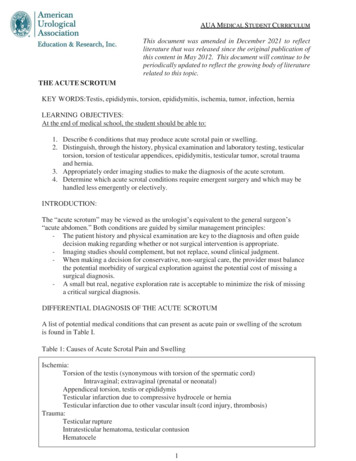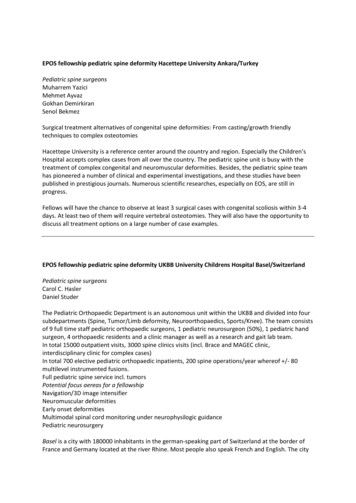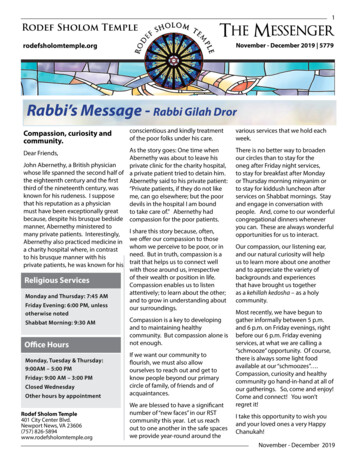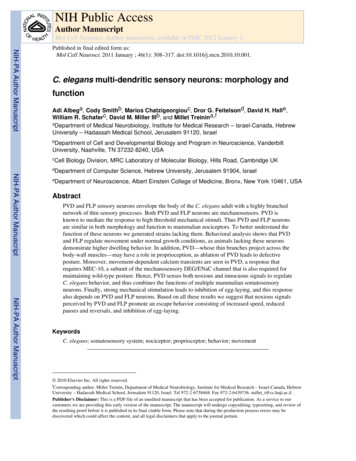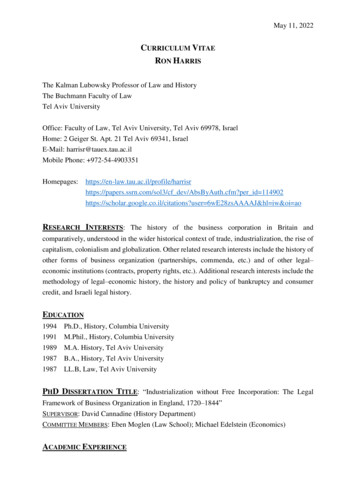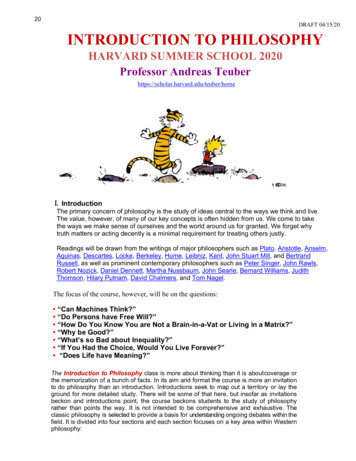
Transcription
DROR PALEYPRINCIPLES OF DEFORMITY CORRECTION
Springer-Verlag Berlin Heidelberg GmbH
DROR PALEYPRINCIPLES OF0 EFOR M I TVCORRECTIONWith Editorial Assistance from J. E. HerzenbergWith More Than 1,800 Separate Illustrations,Clinical Photographs, and RadiographsiSpringer
DROR PALEY,MD,FRCSCDirector, Rubin Institute for Advanced OrthopedicsSinai HospitalCo-Director, The International Centerfor Limb Lengthening, Sinai HospitalBaltimore, MDPresent address:Rubin Institute for Advanced OrthopedicsSinai Hospital2401 West Belvedere AvenueBaltimore, Maryland 21215-5271, USAE-mail: www.deformitycourse.comISBN 978-3-642-63953-1ISBN 978-3-642-59373-4 (eBook)DOI 10.1007/978-3-642-59373-41st ed. 2002. Corr. 3rd printing 2005CIP-data applied forDie Deutsche Bibliothek- CIP-EinheitsaufnahmePaley, Dror: Principles of deformity correction 1 Dror Paley.Berlin; Heidelberg; New York; Barcelona; Hongkong;London ; Mailand ; Paris ; Singapur ; Tokio : Springer, 2002This work is subject to copyright. Ali rights are reserved,whether the whole or part of the material is concerned, specifically the rights of translation, reprinting, reuse of illustrations,recitation, broadcasting, reproduction on microfilm or in anyother way, and storage in data banks. Duplication of this publication or parts thereof is permitted only under the provisionsof the German Copyright Law of September 9, 1965, in its current version, and permission for use must always be obtainedfrom Springer-Verlag. Violations are liable for prosecutionunder the German Copyright Law.http:/ /www.springer.de Springer-Verlag Berlin Heidelberg 2002Originally published by Springer-Verlag Berlin HeidelbergNew York in 2002Softcover reprint of the hardcover 1st edition 2002The use of general descriptive names, registered names, trademarks, etc. in this publication does not imply, even in theabsence of a specific statement, that such names are exemptfrom the relevant protective laws and regulations and thereforefree for general use.Product liability: The publishers cannot guarantee the accuracy of any information about dosage and application contained in this book. In every individual case the user mustcheck such information by consulting the relevant literature.Cover design: E. Kirchner, HeidelbergProduct management and layout: B. Wieland, HeidelbergTypesetting and production: AM-production, Wiesloch24/3150-5 4 3 2 1 oPrinted on acid-free paper
--This book is dedicated to the memory of my father,Zvi Paley, who gave so much and asked for so little.
-ForewordWhat is genius? Analyzing complex problems and finding simple ways to explain them in an understandablemanner. By this definition, this book is genius.The most dramatic progress in orthopaedic surgeryduring the last 2 decades has been in the field of deformity correction. The treatment of deformities has occupied and challenged orthopaedic surgeons since Nicholas Andry. So many brilliant people have worked in thisfield. Among them, Friedrich Pauwel and Gavril Ilizarovshould be individually named. Dr. Ilizarov developednew methods oflimb lengthening and deformity correction and sparked the newfound interest and developments in this field today. In Dror Paley, this spark became a raging fire.Dr. Paley inaugurated many innovations in the fieldof deformity correction. Among them, his nomenclaturedeserves special mention. Before his classification basedon joint orientation, we had a plethora of confusingterminology and definitions leading to a confusion oflanguage reminiscent of the Tower of Babel. Dr. Paley'snomenclature standardizes the terminology in a manner that requires little memorization. This logicallybased system has gained international recognition andacceptance as the single language of deformity analysisand correction. This book presents us with these concepts.The principles and concepts outlined in this bookwere not discovered or understood overnight. They represent an evolution of Dr. Paley's ideas from the past14 years of clinical work in the field of deformity correction. Unlike other texts, which come and go because theyare technique-centric, this tome is principle-based andwill therefore stand the test of time.The limb lengthening and deformity reconstructioncenter created by Drs. Paley and Herzenberg in Baltimore is not only the clinical laboratory where this deformity correction work was developed and understoodbut has also become the Mecca for students in this medical specialty, with visitors from allover the world traveling to learn firsthand from these masters of deformitycorrection. It is in this manner that I first became exposed to the CORA method of mechanical and anatomic axis planning. This has resulted in a long-standing collaboration between our two facilities, centered on ourcommon interest in this subspecialty. We routinely applythese principles to deformity correction at our center inGermany. Many of the new deformity correction devices that I and others are designing are now based on theCORA principles.Dr. Paley'S deformity correction courses around theworld have popularized the planning methods and principles espoused in this book. The annual Baltimore LimbDeformity Course is the foundation for this book, workbook, and CD. Each of its chapters has been presented aslectures at this course, and the workbook and multimedia CD have been tested by live audiences at these courses for many years.I am sure this book will become the bible for the understanding, diagnosis, and treatment of lower limb deformities.Wiesbaden, GermanyJOACHIM PFEIL
PrefaceMy prediction: this book will become a classic. Bravewords, but I can safely make this statement because thisbook is not about the latest surgical operation or aboutour knowledge of certain pathologies, which is constant1y changing. Rather, this book presents a system of deformity analysis that is universal and applicable to anypast, current, or future surgical osteotomy techniquesand hardware. One needs only to think back to medicalschool and realize that most of the textbooks that we socarefully studied are now "of historic interest only:'Grant's Atlas of Anatomy is perhaps the only book frommy medical school days that I still use. I predict that Paley's Principles of Deformity Correction will also have along shelflife. The treatment of skeletal deformity is theheart of our specialty. Indeed, the very name of our specialty, orthopaedics, was coined by Nicholas Andry in1741 as a word derived from two Greek words, orthos(meaning straight) and paedis (meaning child) to indicate his goal "to teach the different methods of preventing and correcting deformities of children" (from Mercer Rang's Anthology of Orthopaedics, 1966).Since Andry's writings 260 years ago, little progresshas been made in understanding, analyzing, and quantifying the types of limb deformities. Rarely do we comeacross an orthopaedic surgeon who is truly an artist (orsculptor). Such an individual does not require accuratepreoperative planning to execute a flawless correctiveosteotomy. However, for the rest of us journeymen orthopaedic surgeons, achieving such beautiful artisticand aesthetic outcomes is elusive. We tend to take awedge here or there, by eyeball estimation, and thenrationalize the less than perfect appearance of the finalX-ray. "It's not bad" or "it should remodel:' True, therehave been attempts by notable surgeons, such as Friedrich Pauwels and Maurice Mueller, to be more precise inour planning. Although we may have received trainingin the precise repositioning of fracture fragments withplates and screws and accurate preoperative planningand templating for hip osteotomies, what has eluded usuntil now is a universally applicable lower extremity deformity planning system that takes into account the entire limb, including associated joint compensation andlever arm considerations: a unified or universal systemthat is equally applicable to the diverse range of ages andpathological abnormalities that come under the purview of the adult and pediatric orthopaedist.It has been my privilege and honor to be associatedprofessionally with Dr. Dror Paley for the past 10 years,and I probably know him better than anyone else does. Ihave therefore been in a unique position to observe howhe developed the CORA method and to contribute as aco-developer, editor, and author. Dr. Paley has an uncanny knack of clearly seeing and understanding orthopaedic deformities. More importantly, he has a uniqueability to then process and integrate this information tomake it accessible to the less clairvoyant. We havestriven to make this method practical and teachable. Itis not hard to learn, but it does take some effort andpractice. The method is mercifully low-tech: the onlytools required are a pencil, ruler, and goniometer. Wehave honed our ability to teach this method during thepast 10 years at our annual Baltimore Limb DeformityCourse, and many of the figures and cases illustrated inthis book have been used in the course. The case studiesand the artists' diagrams are all derived from our ownpractices and are representative of deformities that wehave treated. In this regard, we are greatly indebted toour patients for providing us with both typical and atypical problems to study and illustrate.Interestingly, the CORA method of deformity analysis began simply as an attempt to make some sense of theIlizarov apparatus. As the orthopaedic surgeon who introduced this method in Canada and the USA, Dr. Paleystruggled to understand the concept of the Ilizarovhinge, which is what made the Ilizarov fixator so uniquein its ability to correct deformities in a controlled fashion. In his early experience, he observed some of the secondary deformities that arose from mismatching the location of the hinge and the CORA. In his effort to moreaccurately identify the level for the Ilizarov hinge, he derived the CORA method of mechanical and anatomicaxis planning described in this text.He quickly realized that the concept of the CORA andthe osteotomy rules were not unique to the Ilizarov device but much more universally applicable to deformitycorrection by any method. Indeed, with the CORA method, one can understand and plan surgery for any lowerextremity deformity from the hip to the foot. The gener-
al principle of this book is to first analyze, understand,and quantify the deformity. Only then should you beginto plan your surgical method and approach. Regardlessof which type and brand of fixation is selected (plates,rods, or external fixator), the basic principles of deformity analysis and planning are the same. Failure to observe these principles frequently results in less than perfect alignment and often in secondary deformities thatmay be more difficult to correct than the original deformities. Ultimately, the surgeon must decide which device works best in his or her hands. The first step of preoperative planning, however, is universally required andbeneficial. Chap. 11 includes a discussion of some of thevagaries of selected hardware devices, and it is this chapter that will most likely require updating and revision ina future edition as new device innovations become available. The bulk of the book, however, encompasses principles and concepts that will not change because they arebased on simple geometry.Will the CORA method be supplanted by future technology? We think not. Even computer-dependent mathematical modeling of six-axis deformity correction (seeChap. 12) is first dependent on the surgeon to accurately understand, analyze, and quantify the radiographicdeformity. We therefore think that the CORA methodcomplements rather than competes with such sophisticated deformity correction methods.Is this book the final word on the topic? Clearly not. TheCORA method is still a work in progress, and there isroom to extend its application to the upper extremity,spine, pelvis, and perhaps even maxillofacial deformitycorrection. It has recently been incorporated into computer planning software. This book has already beenlO years in the making, and these other expansions willhave to wait for the second edition. We welcome readers'comments, criticisms, and feedback to help us improvefuture editions.Baltimore, MarylandJOHN E. HERZENBERG
The Story Behind This Book and the CORA MethodMy first exposure to orthopaedics was as a medical student learning physical examination. My patient had a severe limp, which I attributed to weakness of his gluteusmedius. What today I would recognize as an obviousTrendelenburg's gait, in 1977 was the pivotal event thatsparked my interest in orthopaedic surgery. I began toread the works of Rene Caillet (The Biomechanics ofJoints) and of LA. Kapandji (Physiology ofJoints). Theirbooks made human mechanics easy to comprehend,even for a medical student. With Principles of DeformityCorrection, I attempt to do the same regarding deformity analysis and treatment.I am grateful to the many great teachers from my ortho-paedic residency at the University of Toronto. They laidthe foundation for my interest in orthopaedics. Professor Robert Salter set the tone, teaching in a Socraticmanner. Dr. Alan Gross of Mt. Sinai Hospital first taughtme the concept of the mechanical axis of the lower limbas well as the importance of preoperative planning forosteotomies of the hip and knee. He frequently quotedRenato Bombelli's Osteoarthritis of the Hip: Classification and Pathogenesis - The Role of Osteotomy as aConsequent Therapy (Springer-Verlag, 1983) and PaulMaquet's Biomechanics of the Knee: With Application tothe Pathogenesis and the Surgical Treatment of Osteoarthritis (Springer-Verlag, 1984), which stimulated me toread these books on the biomechanics of the hip andknee, respectively. Drs. David MacIntosh and Ian Harrington taught me controversial concepts of high tibialosteotomies and alignment. Dr. Harrington's book onbiomechanics (Biomechanics of Musculoskeletal Injury;Williams & Wilkins, 1982) and his often misunderstoodarticle on high tibial osteotomy UBJS 65(2):247-259,1983] greatly influenced my understanding of conceptsin this field. Drs. Marvin Tile, Joseph Schatzker, RobertMcMurtry, and James Kellam are responsible for teaching me to think in terms of universal principles ratherthan specific surgical techniques. Principles to orthopaedics are like laws to physics: they remain constant,whereas specific operations and techniques come andgo.The widest spectrum and complexity of deformityoccur in pediatric orthopaedics in that many conditions-affect the growth and development of the skeleton. Myteachers at the Hospital for Sick Children, Drs. NorrisCarroll, Colin Moseley, Mercer Rang, Walter Bobechko,Robert Gillespie, and Robert Salter, provided my initialexposure and understanding of the growth plate and thepediatric skeleton. The training I received from themduring my residency and fellowship prepared me tochallenge many well-established practices and beliefs inpediatric orthopaedics. Of all these, I received the greatest support from Dr. Norris Caroll, who always had faithin me and invested his time and patience to teach memeticulous surgical technique and who encouraged meat times of despair.I acknowledge the support of two of pediatric orthopaedics' elder statesmen, Drs. Lynn Staheli and MihranTachdjian. Dr. Staheli, as editor of the Journal of Pediatric Orthopedics, invited me to write about current techniques of limb lengthening in 1988 UPO 8:73-92, 1988)and more recently to write an editorial on deformitycorrection in the twenty-first century UPO 20:279-281,2000). Both of these publications helped introduce andheighten awareness to deformity correction principles.The late Dr. Tachdjian involved me in his internationally renowned pediatric orthopaedic review course since1988 and included my deformity planning method in histextbooks (Pediatric Orthopedics, 1990; and Atlas of Pediatric Orthopedic Surgery, 1994). Dr. Charles Price, whotook over this pediatric course, has included deformityplanning by the CORA method as an important themeof the new course.In November 1983, when I was a third-year orthopaedic resident in Toronto, I met Renato Bombelli whowas a visiting professor. Dr. Bombelli was a disciple ofFriedrich Pauwels and a contemporary of Maquet, another of Dr. Pauwels' disciples. Through their writings, Ibegan to understand that complicated joint mechanicscould be reduced to simple principles. While in Toronto,Dr. Bombelli briefly mentioned the Ilizarov method.This offhand comment sparked my interest in a field totally unknown in North America. Upon completing myresidency in 1985, I visited Dr. Maurizio Catagni in Italyto learn more about the Ilizarov method. The next year,I took my family to Europe and spent 6 months in Italyand the USSR studying limb reconstruction with exter-
nal fixation. I learned that deformities could occur inmultiple planes and that hinges could act as the axis ofcorrection. I learned to consider not only angulation butalso translation, rotation, and length when analyzing adeformity. I also learned that deformities could be corrected gradually or acutely and that there were virtuallyno limits to how much angulation could be corrected.I visited Kurgan three times during the Soviet era, andI am greatly indebted to Professor Gavril AbramovichIlizarov for the opportunity to study at his institute. Although I learned a great deal from Dr. Ilizarov's lectures,articles, and books, he was personally at his best whenexamining patients. Physical examination was a skillemphasized in my training in Toronto during the annual physical examination courses by Mr. Alan GrahamAply. Learning Russian facilitated the learning processand allowed me to speak to the Soviet doctors directlywithout going through interpreters. Many people inKurgan contributed to my education, and some deservespecial mention. Igor Kataev taught me the principle ofhinges and of oblique plane deformity. Mr. Kataev wasnot a physician but was in charge of the patent office atIlizarov's institute. Vladimir Shevtsov, Ilizarov's successor, answered the questions that I would not dare ask Ilizarov. He was direct and not evasive. Victor Makushin'sability to clinically evaluate nonunions was uncanny butcould be divined only by reversing the Socratic methodI learned from Dr. Tile and the others in Toronto. ArnoldPopkov is a master at limb lengthening. He took the middle-of-the-road approach, allowing me to learn by answering my own questions and acknowledging when Ihit upon the correct answers. Others helped in a clandestine fashion to overcome the cold war Soviet secrecy ofthe institute. The best example is Dr. Yaakov Odesky, whois now in Israel. He allowed me to see treatments andconcepts that no Westerners had seen before. Finally,Galena Dyachkova's openness helped me to understandthe basic science of the field of distraction, especiallyregarding soft tissues.In contrast to the struggle to learn in the USSR, Italypresented a refreshing sense of openness. The team,comprised of Roberto Cattaneo, Maurizio Catagni, andAngelo Villa in Lecco, Fabio Argnani in Bergamo, andAntonio Bianchi-Maiocchi in Milan, welcomed me withsincerity, kindness, and warmth and did everything tohelp me learn. I will forever be indebted to them. Ofthese outstanding teachers, Dr. Catagni is most responsible for my current understanding of deformities. Hepossesses an intuitive understanding of deformities andessentially computes a CORA analysis in his head as wellas I can on paper. My goal with this book was to codifyDr. Catagni's intuitive approach into the objective CORAmethod that can be performed in a step-by-step fashionby all. One more important event occurred before all thepieces were in place. When I returned home from Italyand the USSR and began my pediatric orthopaedic fel-lowship in Toronto in 1987, I came across an article byDr. Ken Krackow (Adv Orthop Surg 7:69,1983). This article introduced me to the concept of joint orientationangles and was pivotal in my developing the malalignment test.With this foundation upon which to build, the CORAmethod was developed. Placing hinges on the Ilizarovdevice involved putting the hinge just below the ring formetaphyseal deformities and at the apex of diaphysealdeformities. It did not make sense that the hinge shouldalways be the same distance from the ring for all metaphyseal deformities. For diaphyseal deformities, we always drew two mid-diaphyseal lines and placed thehinge at the intersection of the two lines. In the metaphysis, it was not possible to draw a mid-diaphyseal linefor the metaphyseal bone segment. I struggled with thisproblem until March 1988, when I had to place hinges fora supramalleolar osteotomy for ankle varus where thejoint line was clearly tilted around the lateral cortex ofthe joint yet the osteotomy was much more proximal. Instead of placing the hinges just proximal to the distal tibial ring, I placed the hinge distal to the ring in what isnow recognized as a juxta-articular hinge construct (seeChap. 11). To my fascination, the osteotomy site corrected with angulation and translation. The osteotomy ruleswere born together with the CORA method. The basicconcepts in this book were developed over the next2 years, based to the greatest extent on the clinical casesI had the privilege and the challenge to treat but also ona potpourri of ideas stimulated by colleagues with similar interests. Most notably, Stuart Green from Californiawas my sounding board, especially when it came to posttraumatic deformities. Together, we solved the mysteryof the relationship between the planes of angulation andtranslation. I was privileged to have Dr. Kevin Tetsworth,who has a brilliant mathematical mind, work with me asa fellow between 1989 and 1990. In 1990, we publishedthe malalignment test and the first version of the CORAmethod, although it was not yet called that (Clin Orthop280:48-64; 65-71). Dr. Natsuo Yasui from Osaka, Japan,coined the term CORA method, and it stuck.The initial concept of writing a book about deformitycorrection originated in 1991 through discussions withDarlene Cooke, who was then a book editor at Williams& Wilkins. The syllabus for the first annual BaltimoreLimb Deformity Course served as an outline for thebook. This course began in 1989, with Ilizarov as a featured guest speaker, and has continued ever since. Thesuccess of this annual course led me to add more material and to incorporate the concepts of some very innovative contributors who participated in our course. Ms.Cooke thought that I would never finish the book because I was a perfectionist and continued to add newmaterial every year. In many respects, she was right. Onthe other hand, the book was not ready to be finished.There were several concepts that were on the verge of
being clarified and that needed to be included in thebook to make it complete. For example, the six-axis deformity correction concepts introduced by Dr. J. CharlesTaylor and the lever arm deformity concepts presentedby Dr. James Gage. In 1998, Williams & Wilkins and Iagreed to drop the book project. Without Ms. Cooke asmy editor, the external push to complete the book wasgone. I saw 10 years of work to produce this book goingto waste. I decided upon a new strategy: finish the bookon our own, and then look for a publisher. With the helpof our in-house publishing team, Senior Editor DoriKelly, Medical Illustrator Joy Marlowe, and MultimediaSpecialist Mark Chrisman, this became a reality. It wasnow time to seek a new publisher. This was easier saidthan done. I could not get an American publishing company to share my vision of the importance of this book.The project was finally salvaged by Dr. Joachim Pfeil, myfriend and colleague from Wiesbaden, Germany. Dr.Pfeil has promoted the CORA method in Europe foryears and has co-authored an article on this subject inthe German language. He introduced me to GabrieleSchroeder, Senior Medical Editor for Springer-Verlag inHeidelberg in April 2000. This book has finally come tofruition with the enthusiastic support of Springer-Verlag.This history and my acknowledgments would not becomplete without mentioning a few more people. First isDr. John E. Herzenberg, without whose editorial assistance this book would not have been possible. Dr. Herzenberg has been my colleague and friend since we werefellows together in Toronto in 1985 and 1986. We continued to correspond and collaborate at a distance until1991, when Dr. Herzenberg moved to Maryland to helpachieve our common dream of developing a limblengthening and deformity correction center. The Maryland Center for Limb Lengthening & Reconstruction(MCLLR) was born. John has been a valuable soundingboard for my ideas for more than 10 years. He encour-aged me to continually strive to simplify my concepts tomake them teachable and practical. He has been my CoChairman in the Deformity Course and my loyal partnerin practice. It is often impossible to separate who originated which ideas. Therefore, this book is as much a testament to his work as it is to mine. Second is Anil Bhave,PT. Mr. Bhave has directed our gait laboratory andserved as clinical research coordinator since 1992. Hehas contributed immeasurably to my understanding ofgait and dynamic deformities. The rest of the loyal staffof the MCLLR have also contributed to this book in oneway or another. Kernan Hospital and the Department ofOrthopaedics have given me tremendous support and awonderful environment for my work during the past14 years. lowe them all a great debt of gratitude.Finally, I would like to acknowledge my family. Mywife, Wendy Schelew, and our children, Benjamin,Jonathan, and Aviva, have stood beside me all these yearsand tolerated my single-minded devotion to completingthis project. This book is a testimony to their patience,love, and support. It is also a testimony to my parents.From my mother, a school teacher, I inherited ambition,love for the life sciences, and my skill of teaching. Mygreatest sadness is that my father, who was my rolemodel, will never see this book. He was a holocaust survivor who at age 38 (when I was 10) completed his PhD.He was a mechanical engineer who specialized in metallurgy, working as a research scientist in Ottawa, Canada,until his untimely death from cancer at age 54. My fatherwas a Renaissance man who spoke nine languages andwho stimulated my interest in many fields. Most of all, hetaught me to think critically. He grew up approximately100 miles from Kurgan in the Soviet Union. He never gotto see me complete my residency, raise a family, learnRussian, or achieve the publication of this book. It is tohis memory that I dedicate this book.Baltimore, MarylandDROR PALEY
Contributing AuthorsI am indebted to the chapter contributors, withoutwhose input this book would be deficient. These selectauthors were invited because of their original ideas andcontributions to the field of deformity correction. Thenumbers and titles of the chapters to which they contributed are listed below their names. For the consistency of this book, I have edited and added to each ofthese chapters to better incorporate these authors' ideas.I especially thank my partner, John E. Herzenberg, whoin addition to contributing as an author to two chaptersin the book helped me to develop and also originatedmany of the deformity concepts presented herein. Johnacted as this book's content editor for both the text andthe figures. This laborious task has refined and clarifiedthe theoretical and practical principles that this bookpresents.DROR PALEY, MD, FRCSCANIL BHAVE,PTDirector of Rehabilitation and Gait LaboratoryThe International Center for Limb Lengthening,Sinai HospitalBaltimore, MDCHAPTER 21: Gait ConsiderationsJIM GAGE,MDMedical Director, Gillette Children's HospitalSt. Paul,MNProfessor of Orthopaedics, University of MinnesotaMinneapolis, MNCHAPTER 22: Dynamic Deformities and Lever ArmConsiderationsJOHN E. HERZENBERG, MD, FRCSCCo-Director, The International Centerfor Limb Lengthening, Sinai HospitalChief of Pediatric Orthopedics, Sinai HospitalBaltimore, MDCHAPTER 9: Rotation and Angulation-RotationDeformitiesCHAPTER 12: Six-Axis Deformity Analysisand CorrectionCHAPTER 20: Growth Plate ConsiderationsMICHAEL MONT,MDCo-Director, Joint Preservation and ReplacementCenter, Sinai HospitalBaltimore, MDCHAPTER 23: Total Knee Replacement and TotalHip Replacement Associated withMalalignmentMICHAEL SCHWARTZ, PHDDirector of Bioengineering ResearchGillette Children's Hospital, St. Paul, MNAssistant Professor of OrthopaedicsUniversity of MinnesotaMinneapolis, MNCHAPTER 22: Dynamic Deformities and Lever ArmConsiderationsSHAWN C. STANDARD, MDPediatric Orthopedic SurgeonThe International Center for Limb Lengthening,Sinai HospitalBaltimore, MDCHAPTER 12: Six-Axis Deformity Analysisand CorrectionJ. CHARLES TAYLOR,MDOrthopedic Surgeon, Specialty OrthopedicsMemphis, TNCHAPTER 12: Six-Axis Deformity Analysisand CorrectionKEVIN TETSWORTH,MDDirector of Orthopaedics, Royal Brisbane HospitalBrisbane, Queensland, AustraliaCHAPTER 13: Consequences of Malalignment
Senior EditorDORI KELLY,MAMedical IllustratorsJOY MARLOWE, MAMARY GOLDSBOROUGH,MASTACY LUND, MAMultimedia SpecialistMARK CHRISMAN,Bs
Contributing AuthorsDrs. Dror Paley, MD, FReSe, and John E. Herzenberg, MD, FReseDR 0 R PAL E Y was born in Tel Aviv, Israel, in 1956 andmoved to North America in 1960. He grew up in Ottawa,Canada, for most of his youth. He graduated from theUniversity of Toronto Medical School in 1979, completed his internship in surgery at the Johns Hopkins Hospital in Baltimore in 1980, and completed his orthopaedic surgery residency at the University of TorontoHospitals in 1985. After completing a hand and traumasurgery fellowship at Sunnybrook Hospital in Torontoand the AOA-COA North American Traveling Fellow
Rubin Institute for Advanced Orthopedics Sinai Hospital 2401 West Belvedere Avenue Baltimore, Maryland 21215-5271, USA E-mail: dpaley@lifebridgehealth.org www.limblengthening.org www.deformitycourse.com ISBN 978-3-642-63953-1 ISBN 978-3-642-59373-4 (eBook) DOI 10.1007/978-3-642-59373-4

